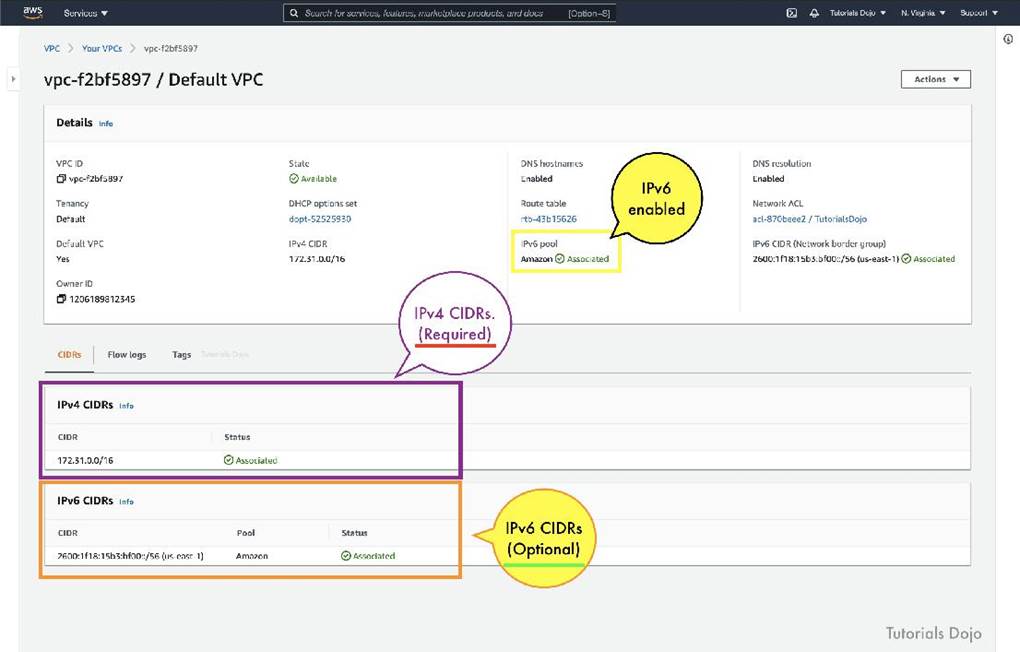- All Exams Instant Download
How should the Solutions Architect resolve this problem?
A company has multiple VPCs with IPv6 enabled for its suite of web applications. The Solutions Architect tried to deploy a new Amazon EC2 instance but she received an error saying that there is no IP address available on the subnet.
How should the Solutions Architect resolve this problem?
A . Ensure that the VPC has IPv6 CIDRs only. Remove any IPv4 CIDRs associated with the VP
C . Set up a new IPv6-only subnet with a large CIDR range. Associate the new subnet with the VPC then launch the instance.
D . Set up a new IPv4 subnet with a larger CIDR range. Associate the new subnet with the VPC and then launch the instance.
E . Disable the IPv4 support in the VPC and use the available IPv6 addresses.
Answer: C
Explanation:
Amazon Virtual Private Cloud (VPC) is a service that lets you launch AWS resources in a logically isolated virtual network that you define. You have complete control over your virtual networking environment, including selection of your own IP address range, creation of subnets, and configuration of route tables and network gateways. You can use both IPv4 and IPv6 for most resources in your virtual private cloud, helping to ensure secure and easy access to resources and applications.
A subnet is a range of IP addresses in your VPC. You can launch AWS resources into a specified subnet. When you create a VPC, you must specify a range of IPv4 addresses for the VPC in the form of a CIDR block. Each subnet must reside entirely within one Availability Zone and cannot span zones. You can also optionally assign an IPv6 CIDR block to your VPC, and assign IPv6 CIDR blocks to your subnets.

If you have an existing VPC that supports IPv4 only and resources in your subnet that are configured to use IPv4 only, you can enable IPv6 support for your VPC and resources. Your VPC can operate in dual-stack mode ― your resources can communicate over IPv4, or IPv6, or both. IPv4 and IPv6 communication are independent of each other. You cannot disable IPv4 support for your VPC and subnets since this is the default IP addressing system for Amazon VPC and Amazon EC2.
By default, a new EC2 instance uses an IPv4 addressing protocol. To fix the problem in the scenario, you need to create a new IPv4 subnet and deploy the EC2 instance in the new subnet.
Hence, the correct answer is: Set up a new IPv4 subnet with a larger CIDR range. Associate the new subnet with the VPC and then launch the instance.
The option that says: Set up a new IPv6-only subnet with a large CIDR range. Associate the new subnet with the VPC then launch the instance is incorrect because you need to add IPv4 subnet first before you can create an IPv6 subnet.
The option that says: Ensure that the VPC has IPv6 CIDRs only. Remove any IPv4 CIDRs associated with the VPC is incorrect because you can’t have a VPC with IPv6 CIDRs only. The default IP addressing system in VPC is IPv4. You can only change your VPC to dual-stack mode where your resources can communicate over IPv4, or IPv6, or both, but not exclusively with IPv6 only.
The option that says: Disable the IPv4 support in the VPC and use the available IPv6 addresses is
incorrect because you cannot disable the IPv4 support for your VPC and subnets since this is the default
IP addressing system.
References:
https://docs.aws.amazon.com/vpc/latest/userguide/vpc-migrate-ipv6.html
https://docs.aws.amazon.com/vpc/latest/userguide/vpc-ip-addressing.html
https://aws.amazon.com/vpc/faqs/
Check out this Amazon VPC Cheat Sheet:
https://tutorialsdojo.com/amazon-vpc/
Latest SAA-C03 Dumps Valid Version with 400 Q&As
Latest And Valid Q&A | Instant Download | Once Fail, Full Refund
Subscribe
Login
0 Comments
Inline Feedbacks
View all comments

